As the name suggests, the Dysdera crocata, or commonly called woodlouse spider, primarily preys on woodlice. The spider can be found all around the world. In the United States, it is mostly seen in the states along the East Coast until Wisconsin and the Mississippi River. Signification populations also exist on the West Coast from Washington to California.

Description of the Woodlouse Spider
The woodlouse hunter has long legs and large fangs. Since it is a hunter spider, these fangs are needed to pierce through the tough exoskeleton of its favorite prey: woodlice. They have a reddish cephalothorax and legs and a light-brown abdomen.
Abdomen – Oblong smooth but dull look to it. Usually a cream or tan color.
Cephalothorax – Near the same size as the Abdomen. It Has a dark brick red color with large chelicerae (fangs).
Eyes
Unlike most other spiders who have eight eyes, the woodlouse hunter has six eyes, all located in the center of the frontal cephalothorax (head).
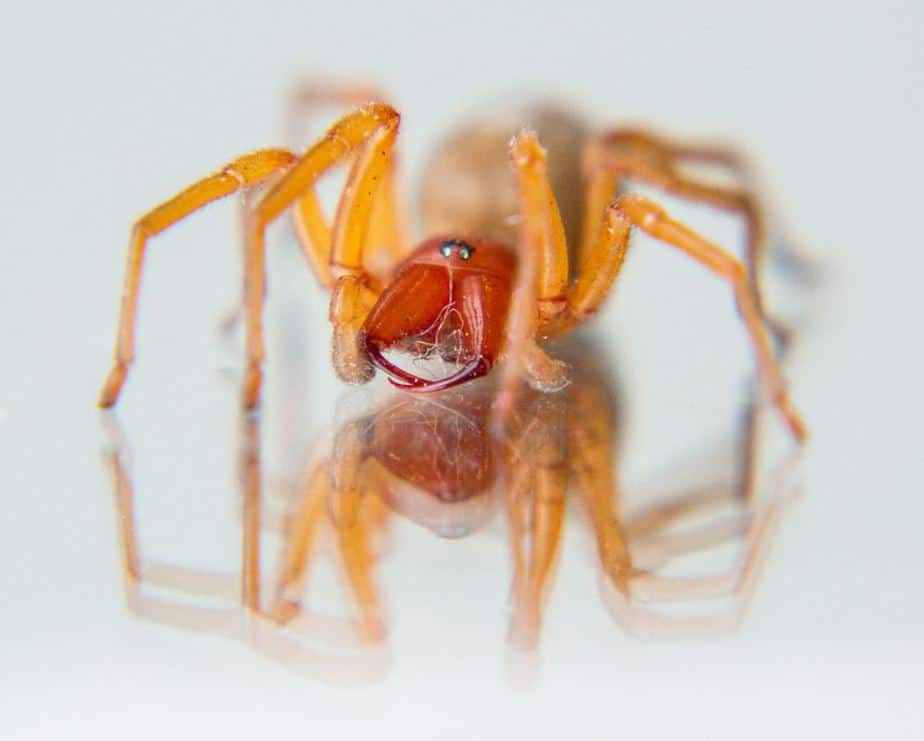
Size
Female woodlouse spiders grow up to 0.6 inches (15 mm) and male specimen up to 0,4 inches (10 mm). Including its legs, the spider can reach twice that size.
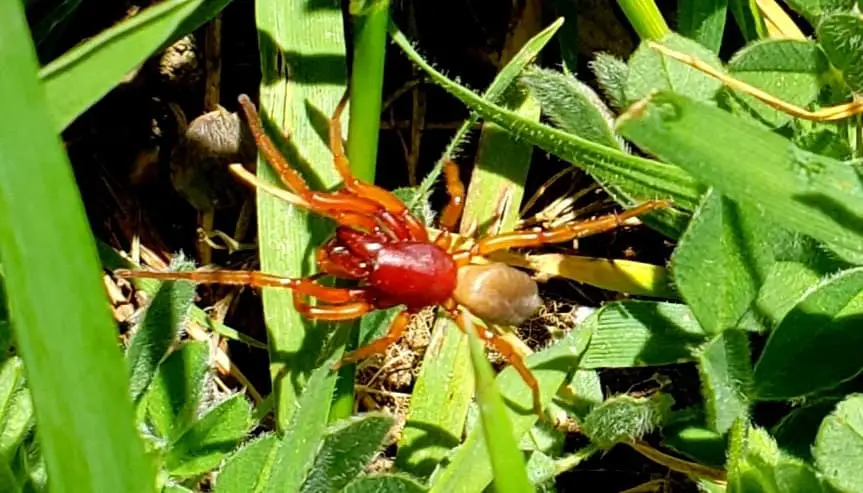
Web
As a hunter spider, the woodlouse spider does not spin a web in order to catch its prey. It can usually be found in areas where woodlice appear and hunts at night.
Woodlouse Hunter Bite
As for most other spider species in the United States, a bite of the woodlouse hunter is slightly painful and may lead to some itchiness or redness. But other than that, there is no actual harm to humans or pets.
However, the woodlouse hunter can have a similar appearance to the venomous and dangerous brown recluse spider. In case of uncertainty or if you feel strange, it is better to still consult a professional after being bitten from what appears to be a woodlouse hunter.
Scientific Classification of Dysdera crocata
- Kingdom: Animalia
- Phylum: Arthropoda
- Subphylum: Chelicerata
- Class: Arachnida
- Order: Araneae
- Infraorder: Araneomorphae
- Family: Dysderidae
- Genus: Dydera
- Species: Dysdera crocata
Common Names
Next to its most common name woodlouse spider, the Dysdera crocata spider is also referred to under the following names: woodlouse hunter, sow bug hunter, pill bug hunter, slater spider, sow bug killer.
Distribution of the Woodlouse Spider in the USA
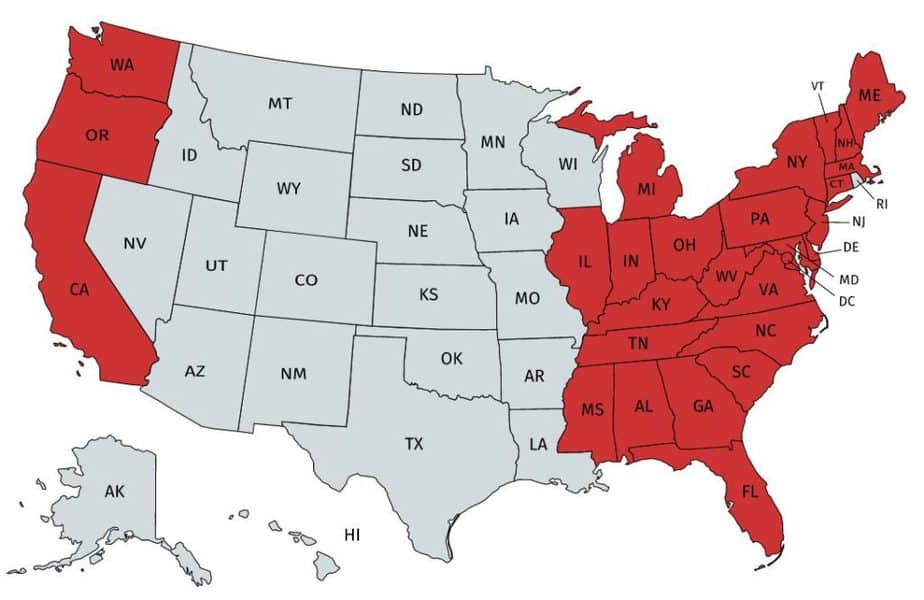
The woodlouse spider can be found along the east coast, east of the Mississippi River and along the West coast from Washington to South California. The woodlouse hunter can be found in the following states: Alabama, California, Connecticut, Delaware, Florida, Georgia, Illinois, Indiana, Kentucky, Maine, Maryland, Massachusetts, Michigan, Mississippi, New Hampshire, New Jersey, New York, North Carolina, Ohio, Oregon, Pennsylvania, Rhode Island, South Carolina, Tennessee, Vermont, Virginia, Washington, West Virginia, Wisconsin.
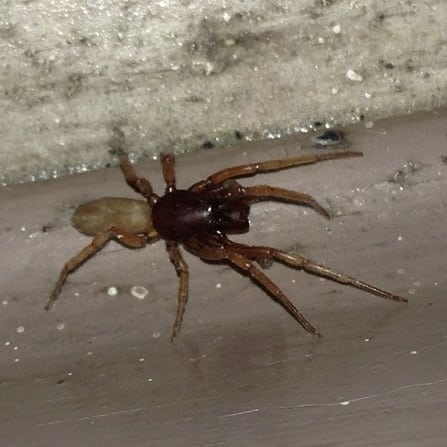
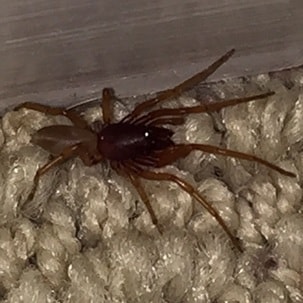

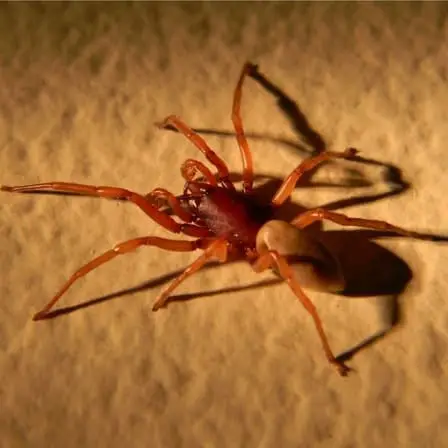
Bright red head light back and legs; Heathsville Virginia
Hello Erica, thank you for getting in touch. From the picture quality, it is quite hard to identify the spider. Based on the picture, together with the description, it could be a woodlouse spider (http://usaspiders.com/dysdera-crocata-woodlouse-spider/). Do let us know if the spider looked like a woodlouse spider.
Best regards,
USAspiders
Greetings,
This spider is a very red spider. Located near Madison wisconsin at a friends house. The grout over which the spider is walking is about 3/8”.
What type is it please?
Thank you.
Regards.
Katrina
Hello Katrina
This is a Woodlouse Spider or Woodlouse Hunter. The spider is harmless: http://usaspiders.com/dysdera-crocata-woodlouse-spider/
Found in East Texas. So you can Texas to your list of places found.
I found this exact one in San Diego, I think. Has the 2 white spots that look like eyes, black head, silverfish abdomen, no other marking that really stood out. Sorry for not great photos – he came out of my hair in the shower, I think.
I found this spider in my house today. I am assuming, based on your responses above, that this is also a broad-faced sac spider. Is that correct?
Thanks for your feedback.
This was awhile ago, but this more like a woodlouse spider because of the wide mouthparts. They’re even less likely to bite, although they look scarier.
How do I get rid of an infestation of woodlouse spiders in my home?
Found this gem in an old moving blanket inside my garage.
RI, USA.
We live in Spokane WA my sister by accident found it on the under side of a black bucket she picked up. Redish orange legs at first it looked like it had a Black body but once we put it into my nieces insect container that has a magnifying lens it has a lighter tanish brown body. I think it’s a woodland spider but not sure.
Hi Anita, thanks for uploading this shot! The gray abdomen suggests that this is probably a broad-faced sac spider (Trachelas tranquillus): https://usaspiders.com/trachelas-tranquillus-broad-faced-sac-spider/
They look very similar to woodlouse spiders but are not medically significant either.
Trying to figure out what kind of spider this is? Found in a basement bedroom in Washington State. Thank you!
Hello Laura, thanks for uploading this picture. This is a woodlouse hunter (Dysdera crocata). It’s not a medically significant spider. More information about it can be found here: https://usaspiders.com/dysdera-crocata-woodlouse-spider/
I live in Baja California in the town of La Mision. Found this while pulling weeds.
Saw this crawling on our fireplace in Tamaqua, pa.
Hello Brianne, thanks for getting in touch! This is a woodlouse hunter (Dysdera crocata). You can read more about it here: https://usaspiders.com/dysdera-crocata-woodlouse-spider/
It’s not a medically significant spider.
Philly spider found in Gritty’s helmet
Hello there, thanks for sharing this great shot! This is definitely a woodlouse spider.
The attached photo is of a spider i found in my kitchen sink today. It appears to be the same type as shown after I answered the identification questions and selected a photo. Would you confirm that its the harmless type. Also is there specific type of bait or insecticide to catch spiders of this size. I think I was just lucky to spot in the kitchen sink – A bait set would have taken care of the intruder – Thanks in advance
Wondering if you can help identify this spider. I am sorry for the poor picture quality. It was found inside my house in Boise, Idaho. Thank you.
Hello Andie, thanks for getting in touch. This is a woodlouse hunter (Dysdera crocata). You can read more about them here: https://usaspiders.com/dysdera-crocata-woodlouse-spider/
Found in Indiana. Crawling across counter top.
Hello David, thanks for getting in touch! This is a woodlouse hunter (Dysdera crocata): https://usaspiders.com/dysdera-crocata-woodlouse-spider/
It’s not a medically significant spider.
Would appreciate help identifying this spider. We live in Los Angeles. Found this guy on my sons bed. Not sure what type it is or if it’s harmful. Thank you.
Hello Selena, thanks for getting in touch! Unfortunately, I can’t really identify the spider in your picture. It’s definitely not one of the very few medically significant spiders found in the U.S. – so it is nothing to worry about.
Is this also a woodlouse spider? It looks a bit different than those in the other photos.
I live in Ventura County CA. And this greeted me this morning literally at my front door.
It had created a web that took up half of my courtyard – not a word to be found in it’s beautiful work!
The spider is about 1 1/2 inches in length, maybe a little smaller but definitely not any bigger.
Thank you so much!!
I appreciate your expertise and information!
Kelly~~
This spider was found in our gym in the Bay Area (Milpitas, CA). lol
Hello Margaret, thanks for sharing this great shot! This is the underside of a woodlouse hunter (Dysdera crocata): https://usaspiders.com/dysdera-crocata-woodlouse-spider/
I found this spider in my home. I live in Northern Utah.
Hi Jenae, this is a woodlouse hunter (Dysdera crocata): https://usaspiders.com/dysdera-crocata-woodlouse-spider/
Found this guy in the northwest suburbs of chicago, illinois
Hi Dom, this is a woodlouse hunter (Dysdera crocata): https://usaspiders.com/dysdera-crocata-woodlouse-spider/
Trying to identify this spider. Found in Washington state, in the town of Clarkston.
Great photo! This is a woodlouse hunter (Dysdera crocata): https://usaspiders.com/dysdera-crocata-woodlouse-spider/
Found this one when I moved my covers to go to bed. I live in northern Ohio. I’ve never seen a spider like this before in person, and I have an idea of what it could be but I would rather have someone else verify for me. I did treat it as if dangerous because I really didn’t want to take a chance if I didn’t and something happened.
Hello Vincent, this is a woodlouse hunter (Dysdera crocata): https://usaspiders.com/dysdera-crocata-woodlouse-spider/
Found this in my son’s bedroom, we are in SoCal.
Hello Nan, this is a woodlouse hunter (Dysdera crocata): https://usaspiders.com/dysdera-crocata-woodlouse-spider/
If you are interested in learning more about spiders in California, check out our California spider identification and information book – available as an ebook here or as a printed paperback on Amazon.
This was crawling on our ceiling. We think it is a woodlouse hunter.
Yes, you are correct!
This not so little guy scared the heck out of me before it scurried under the chest freezer in our basement. It appeared to be light brown and reddish brown, did not look hairy. We are in Waukesha, Wisconsin. Can you identify it?
I just saw this same thing in my office in Pewaukee today.
I believe it is a Woodlouse Hunter. Found on Google, thanks to some help on Reddit.
Hi Merle, yes, this is a woodlouse spider (Dysdera crocata): https://usaspiders.com/dysdera-crocata-woodlouse-spider/
CO TO ZA PAJĄK? I CZY JEST NIE BEZPIECZNY DLA LUDZI?
This was in my bathroom. Almost a very light orange in color. Is this one to be concerned with. His legs spread out wide.
I’m afraid I didnt think to take an image of it before taking it out, I really should, but we just escorted out a specimen of this woodlouse spider from our room in Albuquerque, NM. Confirmed the abdomen, colorations, and the telltale large pedipalps. Not hairy.
Hello! Found this gorgeous specimen while I was hunting wild isopods to keep as a hobby. Found around Portland, Oregon mid-June